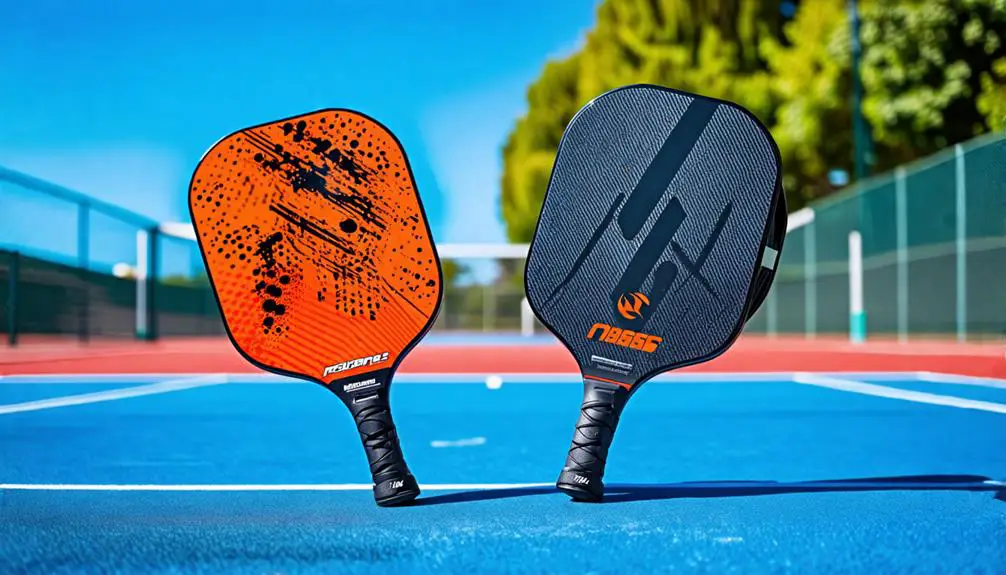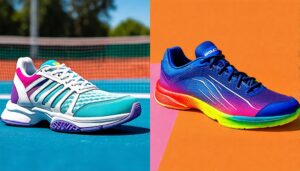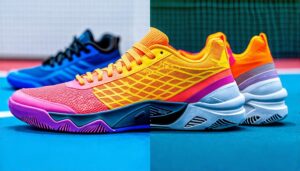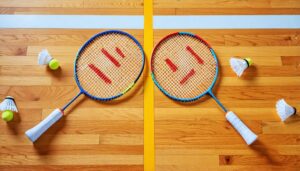When choosing between graphite and carbon fiber pickleball paddles, think about your playing style. Graphite paddles are lightweight and great for quick swings, offering power and comfort. They dampen vibrations well, but may wear out faster under heavy use. On the other hand, carbon fiber paddles are incredibly durable and provide excellent control, while also being lightweight. They resist impact better, making them a solid choice for frequent play. Ultimately, your choice depends on what you prioritize—power or control—so consider how each material aligns with your game. There's more to explore about their performance and cost advantages.
Overview of Pickleball Paddles
When it comes to pickleball paddles, understanding your options can make a significant difference in your game. You'll find that paddles come in various materials, shapes, and weights, each affecting your playing style and safety. Choosing the right paddle is vital not just for performance but also for injury prevention.
Paddle materials generally fall into two primary categories: composite and wood. Composite paddles, often made from materials like graphite and carbon fiber, are lightweight and provide excellent power and control. They allow for quick maneuverability, reducing the risk of strain on your wrist and shoulder. On the other hand, wooden paddles are heavier and typically more affordable, but they may not offer the same level of precision or comfort.
When selecting a paddle, consider its weight. A lighter paddle can help you react quickly, while a heavier one can provide more power. However, if you're prone to injuries like tennis elbow, a lighter option might be safer for you.
Grip size is another important factor. A grip that's too small or too large can cause discomfort and even lead to injuries over time. Make sure to test different grips to find what feels most comfortable in your hand.
Properties of Graphite
Graphite is one of the most popular materials used in composite pickleball paddles, thanks to its unique properties. It offers a combination of strength, lightness, and flexibility, making it an ideal choice for players at all skill levels. Here are four key properties that make graphite a standout option:
- Lightweight: Graphite paddles are considerably lighter than those made from other materials. This allows you to maneuver quickly, reducing fatigue during long matches.
- Strength: Despite its lightness, graphite is incredibly strong. It provides excellent durability, meaning your paddle can withstand the rigors of intense play without easily breaking or warping.
- Vibration Dampening: Graphite has natural vibration-dampening qualities. This helps reduce the shock you feel upon impact with the ball, enhancing comfort and minimizing the risk of arm injuries.
- Power and Control: The unique structure of graphite allows for a perfect blend of power and control. You can hit the ball harder without sacrificing precision, giving you an edge over your opponents.
Choosing a graphite paddle not only enhances your gameplay but also guarantees a safer experience. Whether you're smashing the ball or executing delicate shots, the properties of graphite help provide a balanced and enjoyable game. When safety and performance are your priorities, investing in a graphite paddle is a decision you won't regret.
Properties of Carbon Fiber
When you think about carbon fiber, strength and durability likely come to mind right away. It's impressively lightweight and flexible, making it a popular choice in various applications. Understanding these properties can really help you appreciate why carbon fiber might be the better option for your pickleball paddle.
Strength and Durability
Carbon fiber is renowned for its exceptional strength and durability, making it a top choice for pickleball paddles. When you play, you want a paddle that can withstand the rigors of the game while ensuring your safety. Here are some key reasons why carbon fiber paddles stand out:
- High Tensile Strength: Carbon fiber can resist significant stress without breaking, so you can swing with confidence.
- Impact Resistance: These paddles are less likely to crack or chip upon impact, providing a safer playing experience.
- Longevity: Carbon fiber paddles maintain their integrity over time, giving you a reliable tool for countless matches.
- Lightweight Yet Strong: You get the best of both worlds—strength without the added weight, allowing for better control and precision in your game.
Choosing a carbon fiber paddle means investing in your performance and safety. With their robust structure, you can focus on your game, knowing your equipment can handle the intensity of pickleball. Feel secure knowing that you're playing with one of the toughest materials available.
Weight and Flexibility
Pickleball paddles made from carbon fiber are a favorite among players for their impressive weight and flexibility. These paddles are often lighter than their graphite counterparts, making them easier to maneuver during fast-paced games. This reduced weight allows you to react quickly, which is essential for maintaining safety on the court—especially when you're facing powerful shots from opponents.
The flexibility of carbon fiber also plays an important role in performance. It provides a unique balance that helps absorb shock while still offering excellent ball control. You'll find that this flexibility allows for better touch and precision, making it easier to place shots where you want them.
Moreover, a lighter paddle can reduce the risk of fatigue and strain, which is particularly important for players concerned about injury. With less weight to manage, you can maintain your stamina throughout long matches, ensuring you stay safe and perform your best. So, if you're weighing your options, consider the weight and flexibility of carbon fiber paddles—they could be just what you need for a safer, more enjoyable pickleball experience.
Performance Comparison
When comparing graphite and carbon fiber pickleball paddles, you'll want to evaluate how each material affects your power and control during play. Durability and weight are also key factors that can influence your overall performance on the court. Let's break down these points to see which paddle might suit your game better.
Power and Control
Choosing between graphite and carbon fiber for your pickleball paddle can greatly impact your game, especially regarding power and control. Each material offers unique advantages that can influence your performance on the court.
- Power Generation: Graphite paddles are known for their lightweight nature, allowing for faster swings and more explosive power. You'll feel the difference when you make contact with the ball.
- Control: Carbon fiber paddles provide enhanced control, thanks to their stiffer construction. This means you can place your shots more accurately, which is essential for strategic play.
- Feel: Graphite offers a softer feel upon impact, which can be beneficial for touch shots and drop serves. If finesse is your game, this could be a significant factor.
- Spin Potential: Carbon fiber paddles often excel in producing spin. If you're looking to add that extra bite to your shots, this material may give you the edge you need.
Ultimately, the choice between graphite and carbon fiber boils down to your playing style. Consider which elements of power and control are most important to you, ensuring a safer and more enjoyable game.
Durability and Weight
The durability and weight of your paddle can greatly influence your performance on the court. When you're selecting between graphite and carbon fiber, it's crucial to evaluate how these factors will affect your game and your safety. Graphite paddles are known for being lightweight, allowing for quick swings and better maneuverability. However, they can be less durable, especially if you play frequently or hit hard shots. If a paddle breaks during play, it could pose a safety risk.
On the other hand, carbon fiber paddles typically offer superior durability, standing up to the rigors of intense gameplay. They're designed to withstand impact without compromising performance. While they may be a bit heavier, many players find that the added weight provides better stability and control, reducing the risk of mishits.
Ultimately, if you're focused on safety and performance, you'll want to balance weight and durability. A lightweight paddle may enhance your speed, but a more durable option could keep you safe from potential accidents. Make sure to choose a paddle that aligns with your playing style and prioritizes your well-being on the court.
Cost Considerations
While both graphite and carbon fiber pickleball paddles offer unique benefits, their price points can differ markedly, impacting your decision. Understanding these cost considerations can help you choose the right paddle without compromising safety or performance.
- Material Differences: Graphite paddles typically cost less than carbon fiber ones. The manufacturing process for carbon fiber is more intricate, contributing to its higher price.
- Performance Features: Carbon fiber paddles often boast advanced technology, like improved shock absorption, which can justify their higher price. If you prioritize enhanced safety and performance, these might be worth the investment.
- Durability: While both materials are durable, carbon fiber paddles tend to last longer. If you play frequently, investing in a more expensive paddle could save you money in the long run by reducing the need for replacements.
- Brand Variations: Prices can vary widely between brands. Some high-quality graphite options might rival lower-end carbon fiber paddles, so it's crucial to research and compare features.
Ultimately, you'll want to align your budget with your playing style and safety considerations. Choosing a paddle that's not only affordable but also enhances your game and minimizes injury risk is crucial. Take the time to assess how much you're willing to spend, considering both immediate costs and long-term value. This way, you can enjoy your time on the court with confidence.
Choosing the Right Paddle
Finding the right paddle can make a significant difference in your game, especially after weighing the cost factors of graphite versus carbon fiber options. When choosing a paddle, it's essential to take into account what feels comfortable and safe in your hands, as well as your playing style. Each material has its benefits and drawbacks, so think about what suits you best.
Graphite paddles are typically lighter and offer better control, making them great for players who prioritize precision. If you're concerned about reducing the risk of injury, the lighter weight can help prevent fatigue during longer matches. On the other hand, carbon fiber paddles deliver enhanced power and durability, ideal for aggressive players who want to dominate the court. However, these paddles can sometimes be heavier, so it's worth trying one out to verify it won't strain your wrist or arm.
Don't forget to take into account the paddle's grip size and shape. A paddle that feels comfortable in your hand can prevent slips and improve your overall control. If you're playing regularly, investing in a paddle that promotes proper grip and handling can help minimize the risk of injuries.
Ultimately, it's about finding a balance between comfort, performance, and safety. Before making a purchase, try out different paddles to see what feels right for you. The right paddle can enhance your game while keeping you safe on the court.
Frequently Asked Questions
How Do I Maintain My Graphite or Carbon Fiber Paddle?
To maintain your paddle, it's crucial to know that proper care can extend its lifespan by up to 50%. Start by cleaning it regularly with a damp cloth to remove dirt and sweat. Avoid exposing it to extreme temperatures, as that can weaken the material. Also, store it in a protective case when not in use. Remember, taking these precautions not only keeps your paddle looking great but also guarantees your safety during play.
Are There Any Health Risks Associated With Graphite or Carbon Fiber?
When it comes to health risks, both graphite and carbon fiber materials are generally considered safe for everyday use. However, some concerns arise if you're exposed to fine particles during manufacturing or sanding, which could be harmful if inhaled. It's important to guarantee proper ventilation and wear protective gear if you're working with these materials. Overall, as long as you follow safety guidelines, you shouldn't face significant health risks with these materials.
Can I Customize My Paddle With Graphics or Colors?
Yes, you can definitely customize your paddle with graphics or colors! Many manufacturers offer options for personalization, allowing you to express your style. Just make certain any materials used are safe and durable, as you want to guarantee your paddle performs well during play. Check with the manufacturer about their customization options and any potential impact on the paddle's weight or balance. Enjoy making your paddle uniquely yours while keeping safety in mind!
What Is the Typical Lifespan of Graphite and Carbon Fiber Paddles?
The typical lifespan of high-quality paddles can range from 1 to 5 years, depending on usage and care. It's essential to take into account that over time, wear and tear can affect performance and safety. For instance, did you know that a paddle that's seen better days might lose up to 30% of its strength? To guarantee your game stays safe and enjoyable, regularly check for cracks or signs of damage in your paddle.
Do Weather Conditions Affect the Performance of These Paddles?
Yes, weather conditions can definitely affect paddle performance. If the temperature is too high, the materials might warp or lose their integrity, impacting your game. Conversely, cold temperatures can make the paddles stiffer, reducing control. Humidity can lead to moisture absorption, which can change weight and balance. It's crucial to store your paddles properly and avoid extreme conditions to guarantee they perform at their best and remain safe to use during play.




